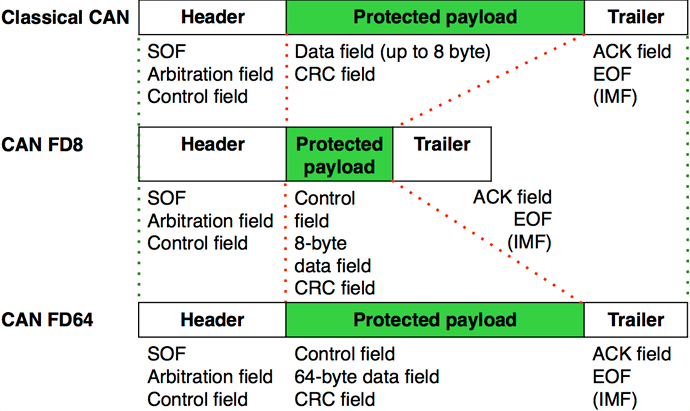
This is the most comprehensive guide to CAN FD. In this guide you’ll learn:
- What is CAN FD
- Benefits
- Applications
- Lots more
Let’s start,
Contents
What is CAN FD?
Benefits of CAN FD
Working principle
CAN FD interface, analyzer
Applications
Automotive Industry Outlook
Chapter 1
What is CAN FD?

In this chapter we will run you through,
What is CAN FD?
Why we need it?
What is CAN FD?
CAN FD full form is CAN Flexible Data-rate, which is an extension of the CAN protocol. It was developed by Bosch and was released in 2012. CAN FD specification is as specified in ISO 11898-1.
Why CAN Flexible Data-rate?
CAN bus has been there since 1986 and has been used in various industries, especially the automotive industry.
When CAN came into existence, the number of electronic components were very few. With the rise of modern technology, the number of Electronic Control Units (ECU) used in vehicles has increased resulting in increased data and increased pressure on Classical CAN.
The Classical CAN handles only 1 Mbit/s and can contain only 8 data bytes, so classical CAN struggles to handle the huge amount of ECU in modern vehicles.
To overcome the limitations of Classical CAN Bosch developed the CAN FD (CAN Flexible Data-rate).
Chapter 2
Benefits of CAN FD (CAN vs CAN FD)

In this chapter we will
look into benefits of CAN
Flexible Data-rate in
comparison with
CAN.
- CAN FD bit rate is higher than 1 Mbit/s and can go up to 8 Mbit/s.
- Supports 64 bytes of data as compared to 8 bytes in classical CAN.
- Improved error detection with enhanced cyclic redundancy check (CRC) and the protected stuff-bit counter.
- Data frames can be transmitted with two different bit rates. Send the control data at a different bit rate and send the actual data at a higher bit rate.
- CAN FD Backward compatibility is an important factor. With some special hardware CAN Flexible Data-rate can be used with classical CAN. This helps in the smooth transition from classical CAN to CAN Flexible Data-rate.
Chapter 3
Working principle

In this chapter we will cover the CAN Flexible Data-rate basics like,
Data Frame
Frame Format and more
The CAN Flexible Data-rate is based on the standard CAN protocol and with a focus on accelerating serial communication while keeping the physical layer of CAN unchanged. The modification to the frame format was done to increase the bandwidth.
In CAN Flexible Data-rate one of the formerly reserved bits called FDF bit is used. If this bit is of recessive value then it is CAN Flexible Data-rate data frame, if it is a dominant value then it is Classical CAN Frame. As mentioned above CAN FD controller supports classical CAN.
Data frames with 11-bit identifiers use the Flexible Data-rate base frame format and 29-bit identifiers use the Flexible Data-rate extended frame format.

CAN FD Frame Format

RRS – Remote Request Substitution
IDE – Identifier Extension
FDF – Flexible Data rate Format
res – Reserved bit
BRS – Bit Rate Switch
ESI – Error State Indicator
Chapter 4
CAN FD interface, analyzer

In this chapter we will
give a brief about what is
required to read CAN FD
messages
Working with CAN Flexible Data-rate requires an interface having CAN FD Transceiver and Analyzer.
CAN FD interface is hardware to connect a CAN bus to the laptop or PC for analysis.
For CAN Flexible Data-rate analysis a CAN bus analyzer software that supports CAN Flexible Data-rate is required which collects the CAN bus data through the CAN Flexible Data-rate interface.
There are many interfaces and analysis software are available.
Chapter 5
Applications

In this chapter we will look into some applications where CAN FD is used like,
Vehicles including Electric and Hybrid vehicles
ADAS applications
As CAN Flexible Data-rate handles more data at a faster rate it becomes very relevant for modern-day applications.
Some of the applications are as below.
Modern Vehicles with many ECUs.

Modern-day vehicles have many ECUs. Some of the modern vehicles can have up to 100 ECUs or even more. So, the amount of data transmitted will be large and requires a higher bit rate. CAN Flexible Data-rate bit rate of up to 8 Mbit/s can be very useful.
Electric and Hybrid Vehicles

The Electric and Hybrid Vehicles have many control units with complex algorithms related to electric power train, charge control, Battery, etc. With the complexity comes the large amount of data that needs to handle. CAN FD could be the ideal choice for these applications.
ADAS

With the introduction of advanced driver assistance systems (ADAS) in cars and commercial vehicles, the amount of data keeps increasing. This puts pressure on CAN and CAN Flexible Data-rate would be a good option.
Chapter 6
CAN FD – Automotive Industry Outlook

In this chapter we will
into future trends for
CAN Flexible Data-rate in
Automotive industry
- As the automotive features continue to grow and increase the pressure on communication network resources CAN Flexible Data-rate has an important role to play.
- New cars with CAN Flexible Data-rate are expected by 2020.
- Hardware cost increases to some extent with the use of CAN FD.
- Looks like CAN Flexible Data-rate and Automotive Ethernet will co-exist in next-generation systems.
Conclusion
It’s clear with the recent trends that CAN Flexible Data-rate is going to grow and would be used extensively.
Keeping the above point in mind, we have covered from what is CAN FD to its benefits to its applications and more.
Now it’s your turn:
Let us know if you need any clarifications or need further information about CAN Flexible Data-rate. Please leave a comment below.



